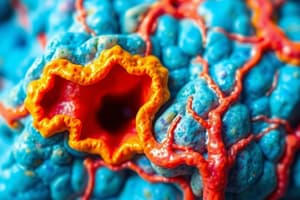Podcast
Questions and Answers
Which type of tissue is responsible for protecting against physical damage and infection?
Which type of tissue is responsible for protecting against physical damage and infection?
- Muscle tissues
- Connective tissues
- Epithelial tissues (correct)
- Nervous tissues
Which tissue type is involved in generating movement and maintaining posture?
Which tissue type is involved in generating movement and maintaining posture?
- Epithelial tissues
- Nervous tissues
- Muscle tissues (correct)
- Connective tissues
What is the primary function of nervous tissues?
What is the primary function of nervous tissues?
- Transmitting signals across the body (correct)
- Transporting nutrients and waste
- Generating movement
- Providing support and anchoring
Which tissue type contributes to heat production?
Which tissue type contributes to heat production?
What is a key function of connective tissues other than providing support?
What is a key function of connective tissues other than providing support?
Which type of tissue facilitates absorption of nutrients and gas exchange in the lungs?
Which type of tissue facilitates absorption of nutrients and gas exchange in the lungs?
What is the primary function of connective tissues like bone and tendons?
What is the primary function of connective tissues like bone and tendons?
Which type of tissue contracts to generate movement and help maintain posture?
Which type of tissue contracts to generate movement and help maintain posture?
What is the role of nervous tissues composed of specialized cells called neurons?
What is the role of nervous tissues composed of specialized cells called neurons?
Which type of tissue generates rhythmic contractions to pump blood throughout the body?
Which type of tissue generates rhythmic contractions to pump blood throughout the body?
Flashcards are hidden until you start studying
Study Notes
The Dynamic World of Tissues: Understanding Their Basic Functions
Tissues are the building blocks of life, constructing the intricate structures of our bodies. These organized assemblages of specialized cells and extracellular materials work together to perform essential functions that ensure our well-being. In this article, we'll delve into the world of tissues, examining their role in maintaining and supporting our bodies.
Tissue Basics
Tissues are classified into four primary categories:
- Epithelial tissues: Covering and lining surfaces, they protect and provide a barrier against environmental factors while allowing for selective transport of substances across cells.
- Connective tissues: Providing support, binding, and anchoring, they also transport nutrients and waste, store energy, and produce hormones.
- Muscle tissues: Contracting to generate movement and maintain posture, they also contribute to heat production.
- Nervous tissues: Consisting of nerve cells, they transmit signals across the body, controlling and coordinating activities.
Functions of Tissues
-
Protection: Epithelial tissues, particularly those lining body cavities and covering external surfaces, protect against physical damage and infection. The skin, for instance, acts as a primary barrier against injury and infection.
-
Absorption, secretion, and transport: Epithelial tissues lining organs such as the intestines, kidneys, and lungs facilitate absorption of nutrients and secretion of waste products, as well as gas exchange in the lungs.
-
Support: Connective tissues, like bone, cartilage, ligaments, and tendons, provide structural support and anchoring points for muscles, offering protection and stability to various body parts.
-
Storage: Connective tissues serve as storage sites for essential substances, such as adipose tissue storing fat for energy or blood vessels storing platelets for blood clotting.
-
Movement and posture: Muscle tissues, such as skeletal muscle and smooth muscle, contract to generate movement and help maintain posture. Heart muscle, though considered part of the cardiovascular system, generates rhythmic contractions to pump blood throughout the body.
-
Information processing and communication: Nervous tissues, composed of specialized cells called neurons, transmit signals across the body, controlling, coordinating, and integrating various functions. The nervous system can be further divided into the central nervous system (CNS) composed of the brain and spinal cord, and the peripheral nervous system (PNS) consisting of sensory and autonomic nerves.
Conclusion
Tissues are the fundamental building blocks of our bodies, working together to perform a wide range of functions essential for our health and well-being. Understanding the basic roles of tissues helps us to appreciate the intricacies of our bodies and the complexity of life. By gaining a deeper understanding of tissues, we can better appreciate their importance and learn to care for them through healthy habits and a balanced lifestyle.
Studying That Suits You
Use AI to generate personalized quizzes and flashcards to suit your learning preferences.




